This is the ultimate snooker guide for beginners. Learn how to play snooker, from the basics and rules to gameplay and tips.
Snooker is one of the most enjoyable and accessible cue sport that can be played by two or more people. The game can be played in teams, such as doubles, or in a one-on-one format. Additionally, one can also practice snooker solo.
Snooker like Golf or any other sport that requires skill is really rewarding and worth sticking at (pun intended). With a bit of practice you can get pretty good and it is a brilliant game to play with friends.
Snooker is a really enjoyable game and you may find yourself completely hooked after a couple of games. So give a go and stick at it, there is nothing like scoring a decent break or potting a long shot into a pocket.
Learn how to play snooker better and explore the basics, rules, gameplay and tips with this ultimate guide for beginners.
Here are the major topics we’ve covered in this snooker guide:
Brief History of Snooker
How People Came to Hit Balls with Sticks
Snooker was originated from billiards, a similar game that was popular among British Army officers stationed in India during the 1870s.
At first, billiards was almost exclusively played by nobility, but in the 19th century, several variations of billiards were devised including black pool and pyramid pool (snooker’s predecessors), leading to the invention of snooker.
Snooker was further developed in 1882 when its first set of rules was finalized by lieutenant Neville Chamberlain.
The word snooker was, at the time, a slang used in the British Army to describe rookie cadets. The name instantly stuck as everyone was snookers at this tweaked version of the game.
In the early 20th century, snooker was predominantly played in the UK where it was considered to be a ‘gentleman’s sport’ but this changed over time and by the early 1960s, snooker had started to gain national popularity and eventually became a global sport.

In 1919, the Billiards Association and Control Club established the standard rules for snooker. Currently, snooker is governed by the WPBSA (World Professional Billiards and Snooker Association) as a professional sport.
📖 Related: The History of Cue Sports
Snooker vs Pool vs Billiards
Know the difference
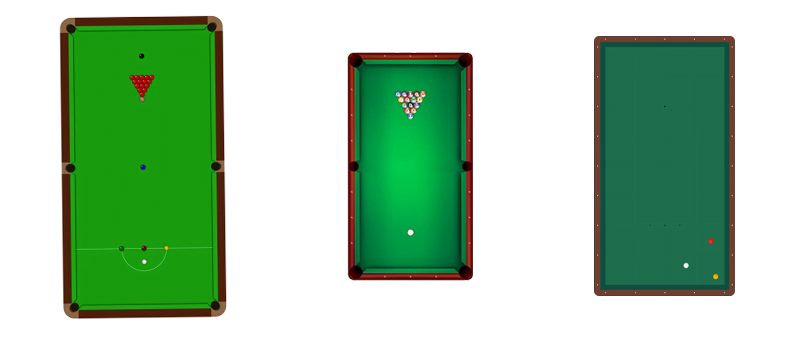
Snooker, pool and billiards are often confused. They fall into the same class of cue sports, but they are 3 different sports each with different rules.
Below are key differences between snooker, pool and billiards.
| Snooker | Pool | Billiards | |
|---|---|---|---|
| Table | Typically 10 feet to 12 feet in length with 6 narrow pockets | Typically 6 feet to 9 feet in length with 6 wider pockets | Typically 10 feet in length without pockets |
| Balls | 22 Balls: White cue ball, 15 red balls, 6 coloured balls (yellow, green, brown, blue, pink, black) Snooker balls are smaller in size (2 1/16”) | 16 Balls: White cue ball, 7 solids, 7 stripes, black 8 ball Pool balls are bigger in size (2 1/4”) | 3 Balls: White cue ball, yellow cue ball, red object ball Billiards balls are bigger in size (2 7/16”) |
| Cue | Average 57 to 59 inches in length | Average 57 to 59 inches in length | Average 54 to 56 inches in length |
| Games | Frame, Power Snooker, Doubles, Century, Points etc | 8-ball, 9-ball, blackball, 10-ball, 7-ball, one-pocket, bank pool etc | 1-cushion, 3-cushion, straight rail, balkline, artistic billiards etc |
Why Play Snooker?
Reasons why snooker is such a great sport
Snooker is a game that requires a high level of practice, accuracy, patience, determination, and positivity. Apart from being a leisure activity, snooker is excellent for improving life skills and mental health.
Here are just a few reasons why snooker is such a great sport to pick up.
Good For Health 💪
Scientific evidence suggests that sports activities such as snooker or pool are good for physical and mental health and boosts one’s mood.
Playing snooker helps increase the production of happy hormones and reduce stress and anxiety.
Playing snooker also requires some form of physical activity as it requires players to walk around the table and stretch while playing some shots. This is good for joint mobility.
Develops Life Skills 🧠
Snooker can help develop life skills as it encourages mental activity related to concentration and logical thinking. Since the game involves focus, imagination, problem-solving and spontaneity, these mental exercises can translate to improved critical thinking in almost every part of life.
Children and adults that play snooker tend to develop better and sharper hand-eye coordination, teamwork, strategizing, and a variety of other skills that help them get ahead in life.
📖 Related: Snooker Psychology – Unlocking The Mental Game
Improves Social Life 👥
No matter how young or old you are, there’s nothing stopping you from learning or playing snooker. Its a game that anyone can play regardless of age or gender. A game of snooker allows everyone to get a fair chance to play, strike up conversations and make new friends.
📖 Related: 10 Life Lessons You Can Learn From Snooker
When you combine the mental and social benefits of snooker, snooker is by far one of the most beneficial games that people of all ages can enjoy.
Snooker Equipment
Snooker equipment and accessories you should know about.
Snooker Table
Snooker is typically played on a 12 x 6-feet table that has 6 pockets. You can also find snooker tables measuring 10 x 5-feet. Snooker tables are larger than pool tables with smaller pockets.
Here’s a snooker table at start of game:
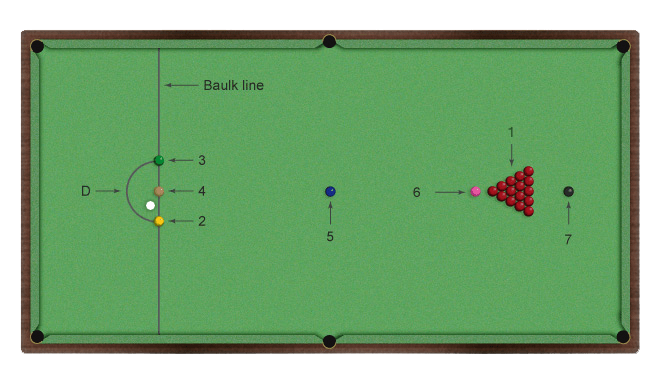
📖 Related: How to Choose the Right Snooker Table – Buyer’s Guide
Snooker Balls
- ⚪ Cueball – the white ball, the only ball that you may hit with the cue
- 🔴 Red – red in color, there are 15 at the start of the game (sometimes 6 or 10 may be used)
- 🌈 Color – one of the six balls that are neither red nor white
To remember the order of the colours in the “D” area, think of “God Bless You“ as you look at them from the end of the table left to right.
- God (green) 🟢
- Bless (brown) 🟤
- You (yellow) 🟡
Balls in snooker have the following points:
- Red = 1
- Yellow = 2
- Green = 3
- Brown = 4
- Blue = 5
- Pink = 6
- Black = 7
Snooker Accessories
Here are a few accessories that you’ll likely hear about once you start playing snooker. While not all of them are necessary to play the game, they’re good to be aware of and keep in mind.
The most basic equipment you are going to need to play is a cue stick and some chalk.
- Cue – A cue stick is used to strike the cue ball. Most snooker cues are made of wood, are 57–58 inches long, can weigh between 450 and 550 gram and have detachable butt extensions.
The slimmer, longer end of the cue having a cue tip, is called the shaft. The thick, heavy and short end of the cue, opposite the tip is called the cue butt. The shaft and butt are joined together with a male-female screw ring joint.
A snooker cue tip is usually made of compressed leather, can range from 8.5 – 10.5 mm in diameter and is glued to the shaft-end of the cue.
- Cue Extension – makes your cue longer for hard to reach spots on the table. A rest and extension can be combines for far off shots.
- The Rest – this is used to help you take a shot that is too far away to be bridged by hand. A rest looks like a cue but has a head on the end to set the cue on when taking your shot.
Rest head variations:- X – the regular rest with an x-shaped head
- Spider – a tall rest used to reach the cueball over another ball
- Swan Neck – used for obstructed shots when more height is needed
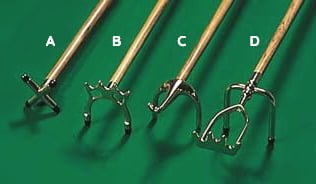
D: Extended Spider
Related: Full use of table equipment (Video)
- Chalk – Chalking the cue tip before each shot is important in snooker because it helps to increase friction between the cue ball and the tip, which allows for better control and accuracy when striking the cue ball. The chalk also helps to prevent the cue tip from slipping off the cue ball when it is struck.

Snooker Basics
Snooker essentials you must know.
Snooker Terms
Here are some common snooker terms you should know. Knowing and understanding these terms is important in order to play the game correctly and follow the rules, as well as to understand the commentary and analysis of professional matches.
Basic Snooker Rules
These basic snooker rules are important as they define how the game is played and how points are scored.
Understanding these rules is essential in order to play the game correctly and follow the rules.
Additionally, these rules are also important to understand while watching a professional match, as they will give you a better understanding of the strategies and decisions being made by the players.
At the beginning of a frame:
- For the first frame, you can decide who goes first to break by tossing a coin.
- A frame begins with the break-off shot, where the cue ball is placed anywhere inside the D and the player attempts to hit one or more of the red balls.
- On subsequent frames, the break-off alternates between players.
At the end of a frame:
- If there is a tie at the end of the frame, you can break this tie by flipping a coin and re-spotting the black ball.
- The player who wins the coin toss can choose to go first or allow the opponent to initiate the tie breaker.
- On a re-spotted black, the player who pots the black ball wins.
A frame ends when:
- All reds and colored balls are pocketed.
- A player concedes due to being too far behind to have a realistic chance of winning the frame, even by forcing snookers.
- A player misses the ball ON 3 times in a row (when not snookered).
Snooker Foul Rules 🚨
In snooker, a foul refers to any shot or action made by the striker that violates the rules of the game.
When a foul is committed during a shot, the player’s turn is ended with no points added and the opponent will receive penalty points.
Penalty points can be at least 4 points and at most 7 points. When more than one foul is made in a single shot, only the highest value penalty is applied.
Understanding snooker foul rules is important as they define and ensure that the game is played in a fair and legal way.
Here are some common foul rules in snooker.
Miss: A miss is when the cue ball fails to first contact a ball ON (snookered or not) and the referee considers that the striker has not made a good enough attempt to hit a ball ON.
- The opponent may choose to take the shot, turn the table back to you or have the balls replaced.
- The penalty is the value of the ball ON/hit or 4 points, whichever is greater.
- The Miss rule was developed to prevent “deliberate fouls” in the game.
- A Miss can’t be called if it is impossible to hit the ball ON.
- A Miss can’t be called when a player requires 1 or more snookers to win.
Foul And A Miss: Failure to hit the ball ON first (foul) and the referee considers the shot to not be the best possible attempt (miss).
Three Miss Rule: Failure to hit a ball ON “full ball” 3 times in a row (when not snookered). The referee will warn a player after a second miss that a third miss will result in a loss of frame.
Free Ball: If you commit a foul and your opponent is snookered on all balls ON, he may be allowed to select a free ball (any ball on the table). The free ball, for this shot only, becomes another ball ON and has the same value and is re-spotted if potted.
Touching Ball: A touching ball is when the cue ball comes to rest touching another ball or balls that are, or could be, ON.
- If the cue ball is touching ball(s) ON, the striker must play the cue ball away from touching ball(s) without disturbing it/them (to avoid a push shot). No need to hit another ball ON in this case.
- If the cue ball is touching ball(s) not ON, the striker must nominate a legal ball ON and play the cue ball away from touching ball(s) without disturbing it/them (to avoid a push shot). The cue ball must first hit the ball ON in this case.
Re-spotting:
- If the cue ball goes off the table, your opponent gets to place the cue ball anywhere in the D.
- Foul reds are left off the table but foul colours are re-spotted on the table.
- If the spot for colored ball is occupied, the ball is placed on the next highest available spot.
Foul Shots:
- Push Shot – When the cue tip remains in contact with the cue ball;
- while the cue-ball is moving after the initial stroke, or
- while its touching the object ball (whether ON or not), unless the cue ball hits a very fine edge of the object ball.
- Jump Shot – When the striker intentionally jumps the cue ball over an obstructing ball.
Foul Points:
| Foul | Penalty |
|---|---|
| Touching any ball on the table at any time. | Value of the ball touched or 4 points, whichever is greater. |
| When all balls aren’t stationary while a shot is played. | Value of the ball ON or 4 points, whichever is greater. |
| Hitting the cue ball more than once on the same shot. | Value of the ball ON or 4 points, whichever is greater. |
| When a player doesn’t have at least some part of one foot on the ground whilst playing a shot. | Value of the ball ON or 4 points, whichever is greater. |
| Cue ball initially strikes a ball not ON. | Value of the ball struck or 4 points, whichever is greater. |
| Potting a ball other than the ball ON. | Value of the ball potted or ball ON or 4 points, whichever is greater. |
| Potting the cue ball. | Value of the ball ON or 4 points, whichever is greater. |
| When the cue ball or a colored ball goes off the table. | Value of the ball or ball ON or 4 points, whichever is greater. |
Snooker Gameplay
Learn how snooker is played
Snooker Objective
The objective of snooker is to outscore your opponent by pocketing the object balls in the correct order to win the frame (game).
An individual game of snooker is called a frame. A snooker match is normally divided into a predetermined number of frames.
A snooker frame is won by scoring the most points. A snooker match is won by winning most frames (best-of 3, 5, 7, 9, 11 etc)
How To Play A Snooker Game
The game contains 22 balls on the table (including the white cue ball), each with different values. which must be pocketed in a certain order using the cue stick and cue ball.
Rules govern which ball can be pocketed on a given turn (Ball ON) i.e. if a red ball is pocketed, this must be followed by a colored ball, which must in turn be followed by a red ball.. So on and so forth.
When there are still reds on the table:
- Your first shot on every turn must be to hit a red with the cueball
- If you pot that red (red is the ball ON), then you score 1 point and your next shot may be on any of the nominated colours. The red stays in the pocket.
- If you pot that colour (which is now the ball ON), then you score the value of the colour and your next shot must be a red. The colour goes back on its own spot. If the spot is occupied, then it goes on the highest valued spot available.
- If you fail to pot, or if you foul, then your turn is ended and your opponent gets to try (see foul rules for details)
- Continue with red-colour-red-colour until all red balls are in the pockets
When all red balls are gone:
- Balls are pocketed based on their value, from lowest to highest – Yellow (2), Green (3), Brown (4), Blue (5), Pink (6), Black (7). They stay in the pocket.
Winner:
- The player with the most points at the end of the frame wins.
- The player who wins most frames wins the game.
Types of Snooker Shots
Master these shots to master the game!
If you want to be competitive in snooker, it is important to understand the different types of shots.
Here’s a quick overview of the essentials:
Spin Shots
A spin shot is achieved by striking the cueball off-center, which causes it to rotate (spin) in the direction of the strike.
Spin affects the path of the cueball after it makes contact with the object ball and the cushion (rails).
An easy way to calculate where the cue ball will go is to imagine a clock face 🕕 on it.
- Striking the cue ball at 12 o’clock (above centre) will cause a top spin
- 6 o’clock (below centre) will give you bottom spin
- 9 and 3 o’clock will result in a left and right side spin respectively.
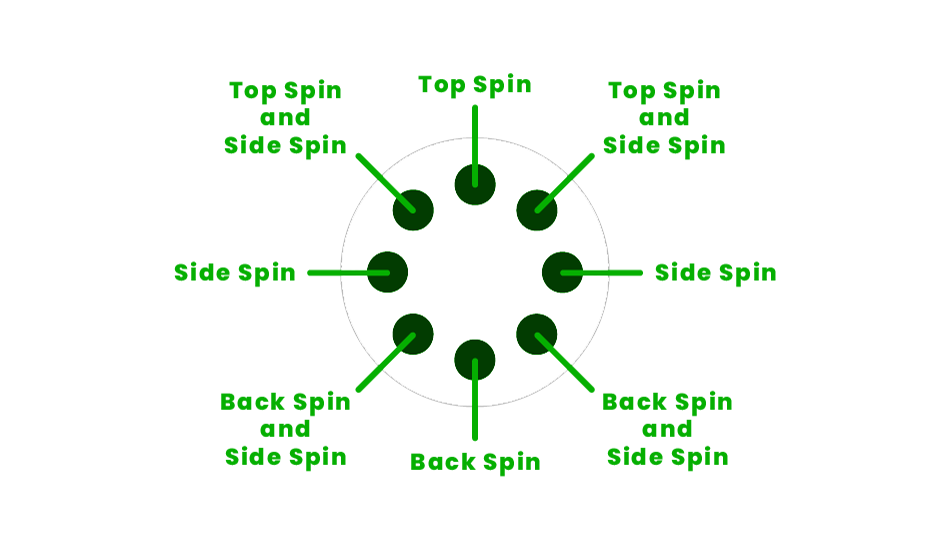
Striking the cue ball between these points will result in a greater variation of cueball’s path.
Applying spin gives you more control of the cue ball after it has struck the object ball or table’s rails, allowing you to control the final position for the next shot. It can also be used to get out of tricky situations i.e. escaping a snooker.
⚠️ The degree of spin depends upon the pace of the stroke.
Top Spin
Top spin (follow through) is achieved by striking the cueball above center (12 o’clock), which causes it to spin forward.
A topspin shot is played by raising the bridge and slightly lowering the butt of the cue.

Back Spin
Back spin (bottom/screw back/deep screw) is achieved by striking the cueball below center (6 o’clock), which causes it to spin backwards.
A backspin shot is played by lowering the bridge and slightly raising the butt of the cue.

Side Spin
Side spin (right/left spin) is achieved by striking the cueball on the right/left side from center (3/9 o’clock), which causes it to spin sideways after striking the object ball or table’s rail.

💡 The spin shots mentioned above can be merged for different effects i.e. striking the cue ball between 12 o’clock and 3 o’clock will result in a combination of both top and right side spin.
Stun Shot
A shot where the cue ball has no topspin or backspin and is skidding (drag) when it strikes an object ball.
To play a stun shot, apply enough bottom with the right amount of speed, so that the friction of the cloth kills the backspin just as the cue ball strikes the object ball.

A stun shot that has a little follow (top spin) on the cue ball after impact (controlled follow) is called a stun run-through. It is considered as one of the most difficult shots in snooker.

Stop Shot
A stop shot is a straight stun shot with no cut angle. With a stop shot, the cue ball stops in place after hitting the object ball.
To achieve this, the cue ball must have stun (no top or bottom spin) at object ball impact.

Swerve Shot
A swerve is an observable curve applied to the path of the cue ball. To swerve a shot is to curve the cue ball around other balls on the table by elevating the cue butt and combining bottom and side spin.
The amount of swerve depends on the force with which you strike the cue ball, elevation of the cue and the spot you hit on the cue ball.

Massé Shot
Massé is an extreme form of swerve played by exaggerating the cue butt elevation and striking the cue ball downwards and off-center so that it takes a curved path or changes direction.
Massé shots often require more than 60 degrees of cue elevation, but you can still get plenty of spin with swerve shots by keeping the cue angle under 45 degrees.
💡 Swerve and massé shots are useful as a way to go around a ball that’s in the way of your shot. To aim, you’ll need to imagine the curved path first.
💡 The higher the elevation of the cue, the more severe the degree of curve.
Safety Shot
The objective of a safety shot is to play a shot that is both defensive and strategic, minimizing the risk of your opponent scoring points while setting up a scoring opportunity for yourself in future turns.
Some common safety shots include:
- The first shot played in each frame (break-off) to leave your opponent in a tough position.

- A snooker is the best type of safety shot because it leaves the opponent unable to hit a ball ON directly.

- Leaving the cue ball close to a cushion, making it difficult for your opponent to play an attacking shot.

Safety shots are an important part of snooker strategy, and are often used by players to gain a tactical advantage in a match.
Players who are skilled at playing safety shots can effectively control the pace and direction of the game, and force their opponents to make mistakes.
Related: Safety and Long Potting Overpowered Snooker Skills
Combination Shots
Combination shots in snooker require a lot of skill and practice to execute successfully. There are two main types of combination shots in snooker:
Cannon
A cannon is a type of combo shot where the cue ball strikes two or more object balls in the same shot.

Plant
A plant is a type of combo shot where the cue ball causes an object ball to contact another object ball in the same shot.

Doubles
In snooker, a “double” refers to a shot where the object ball is potted off one or more cushion(s).
A double off two cushions is known as a “treble”, whereas a double off three cushions is called a cocked-hat double.
Doubles can be played in many different ways. The most common and relatively easier double is the center pocket cross or back double along the width of the table.
A long double played along the length of the table is more challenging and difficult to judge. A cocked-hat double is the most difficult to execute as it is played off three cushions.

Doubles can be used as an attacking shot towards the end of a frame or to begin a break when nothing else is available for you to pot.
Related: Playing Doubles
Using the Rest
A rest is an essential accessory in snooker as it increases the length a player can reach across the table. Using various rests is something that shouldn’t be overlooked when practicing as many shots are impossible without them.
Different rest heads perform different functions, e.g. the cross allows you to play a shot that is too far away to be bridged by hand, whereas the spider and swan help navigate a shot over an obstacle.
Rests can often be used in unusual ways to bridge over a group of balls.

You can be creative and use rest combos too i.e. spider-cross combo shot.

Some players even lift the cross rest up in mid-air, and are as steady as a rock to pot a ball.

Making full use of the table equipment effectively requires skill and practice. It can make a difference between making a difficult shot and missing it entirely.
Hampered Cueing
When playing snooker, there are many instances where you may be faced with hampered cueing. This could be in the form of:
- Bridging over another ball
- Playing from tight on the cushion
- Bridging over the jaws of a pocket

Hampered cueing happens all the time in cuesports. It makes your shot a lot harder and cueing more difficult. Mis-cueing off such awkward shots is very common.
The key to master awkward cueing lies in keeping your bridge as firm as possible. Stability is most important to cue smoothly. It takes practice to develop a correct bridging technique as we are all built differently with different reaches and hand sizes.
💡 Keep your bridge hand stable by putting some weight onto your fingers.
Frozen Cushion
A Frozen Cushion shot refers to a shot where the object ball is touching or very close to the cushion (rail).

When the object ball is frozen to the cushion, apply a touch of side (opposite direction to the cushion) on the cue ball and strike the cushion just before the object ball to slide it along the cushion into the pocket.

When both cue ball and object ball are frozen to the cushion, apply a touch of side (same direction to the cushion) on the cue ball – sending the cue ball away from the cushion curving back into the object ball.

Snooker Techniques
Some essentials to get right
There are several factors that you should take into account when playing snooker. The more you improve them, the better your overall game will become.
The main things to concentrate on for your game are grip, stance, bridging, cueing, sighting and angles.
Grip
Your grip is the way you hold the butt of the cue in your hand.
How you grip your cue is very important. Try not to grip too tightly or too loosely. Your grip should just feel natural.
💡 A good tip for finding your natural grip is to place the cue flat on the table and pick it up as if you were going to hit someone with it – this is your natural grip.
Stance
Your stance is your position when you take your shot. With your stance you want to maintain a firm base. If you are right handed you need to ensure that most of your weight is over your left foot.
Keep your right leg straight and bend your left knee to get down low on your cue and ensure maximum accuracy.
Bridge
Your bridge hand is the hand you place on the table. Your bridge should be firm but loose enough for the cue to move smoothly.
An open bridge is the most popular in snooker for playing different types of shots. The bridge hand is usually the non-dominant hand.
To begin making a bridge, place your hand flat on the table and spread your fingers apart. Raise your knuckles up while keeping your fingertips on the table and bring your thumb up to the forefinger ensuring that it doesn’t move when cueing. This should give you a really good base to run the cue through.
Cueing
A good cue action is a vital skill in snooker and will ensure that you hit the ball straight and accurately.
When you are cueing try to keep your arm very still and when you hit the ball ensure that your elbow which is holding the cue is in direct line with the cue. Try to avoid sticking your elbow out or tucking it in too tight to your body.
At final backswing, re-focus your eyes on the object ball and keep looking at it throughout the shot.
💡 When playing a shot, your cue arm is the only part of your body that should move. This will optimise your chances of potting the ball.
Sighting
Sighting is one of the most important aspects in snooker. First, you need to find out which is your dominant eye.
💡To aim a shot correctly, your dominant eye should directly be above the cue while it touches your chin.
When you lower down and prepare to take your shot, you need to switch your glance back and forth between where the cue is going to strike the cue ball and the point on the object ball you want to hit.
What you are trying to accomplish here is check that the line of your shot is accurate.
💡While taking the shot, keep your eyes on the object ball when striking the cue ball.
Angles
Table geometry is a huge part of snooker. Learning to read angles on the table will significantly improve your game.
You need to be able to understand and mentally visualize the angles involved in the shot in order to be able to pot or lay/escape a snooker.
Potting Angles
You must consider the potting angle before getting down on a shot. Potting angle is the angle at which the cue ball must be hit in order to pot an object ball.
The potting angle can vary depending on the position of the cue ball, object ball, and the pocket.
Potting angles can be affected by factors such as the speed of the cue ball, the spin applied to the cue ball, and the length of the shot.
After playing the shot, stay down and observe the path of the object ball with your eyes. Your brain will calibrate itself to judge the right potting angles as long as you give it the feedback it needs.
💡 Stand behind the object ball to imagine a straight line from it to the pocket, that’s your line of aim.
Ghost Ball Method
Imagine a straight line from the pocket through the centre of the object ball. Now imagine a “ghost ball” on this line touching the object ball. Aim at the center of the ghost ball to send the object ball into the pocket.
💡 The “ghost ball method” is an easy way to visualize and estimate a cut angle.
💡 After collision, the angle between cue ball’s path and object ball’s path will always equal 90º (as long as there’s no spin involved). Remember this to avoid sinking the cue ball.
Law of Reflection
The angle at which a ball strikes the cushion is equal to the angle the ball bounces off it (as long as there’s no spin involved).
💡 If the ball approaches the cushion at a 30º angle, it will bounce off at a 30º angle as well.
By understanding the law of reflection, you can predict the path that a ball will take after it bounces off a cushion.
Once you’ve understood table geometry and potting angles and delivering the cue reasonably straight, it’s really just a matter of practice and observation until everything becomes a muscle memory.
Snooker Etiquette
The biggest Do’s & Don’ts of Snooker
Snooker is a sport in which there are quite a few official and unspoken rules. Not following them may be interpreted as ungentlemanly conduct.
Below are some key points to be aware of if you’re at a snooker club:
- Turn your phone on SILENT/OFF while playing.
- Keep your voice down. Talk, but don’t yell and disturb others.
- Don’t stand or move in front of players when they’re down on the shot.
- Don’t chalk your cue loudly while your opponent is taking their shot.
- Don’t stand in between the tables when you aren’t on your shot.
- Don’t leave your chalk on the rail when you’re not playing.
- Call your own foul even if the opponent didn’t notice.
- Re-spot colors when the opponent is playing.
- Concede the frame if you need a couple of snookers with a few remaining colors
- Don’t concede a frame unless snookers are required and when you’re the striker. It is ungentlemanly to concede when its your opponent’s turn.
- Apologize for flukes with a cursory raised hand.
- Celebrate respectfully. If you win a frame because your opponent makes an error, don’t celebrate.
- Win or lose, shake hands with your opponent after a match.
Most of these rules are very basic that have been observed over the years. Always be humble, courteous, and respectful. It’s good sportsmanship to keep these basic snooker conduct in mind.
Did I miss anything? Comment them down below!
Snooker FAQs
Frequently Asked Questions about Snooker
Snooker World Records
Snooker world records and best TV moments
There have been many memorable moments in the history of snooker, and several players have set world records in the sport. Here are a few examples:
- In 1997, Ronnie O’Sullivan set the record for the fastest maximum break in snooker history, completing a 147 in 5 minutes and 8 seconds at the World Snooker Championship.
- In 1982, Steve Davis became the first player to make a televised 147, during a match against John Spencer at the Lada Classic.
- In 1994, Jimmy White reached the World Snooker Championship final for the sixth time, but lost to Stephen Hendry. This match is considered one of the greatest in snooker history, and is known as the “People’s Final.”
- In 2019, Ronnie O’Sullivan made the 1000th century break of his career in style to win the Players Championship final.
- In 1996, Tony Drago made the fastest recorded century break (3 minutes 31 seconds) in tournament play at the UK Championship.
These are just a few examples of memorable moments and world records in snooker. There have been many other great moments in the sport’s history, and no doubt there will be many more in the future.
Snooker Legends
The Players that Pocket them All
There have been many great snooker players throughout the history of the game. It’s rather difficult to choose between so many magnificent players, but a few of the most famous snooker legends include:
Joe Davis: Considered the “father of modern snooker,” Davis won the first-ever World Snooker Championship in 1927 and went on to win a total of 15 world titles.
Stephen Hendry: A dominant force in the 1980s and 1990s, Hendry won a record 7 World Snooker Championships and was ranked world number one for a record eight consecutive seasons.
Alex Higgins: Nicknamed “The Hurricane,” Higgins was known for his exciting, flamboyant style of play and won the World Snooker Championship twice in the 1970s.
Jimmy White: Known for his exciting, attacking style of play, White reached the final of the World Snooker Championship six times but was never able to win the title.
Steve Davis: Known for his cool, calculated style of play, Davis won 6 World Snooker Championships and was ranked world number one for a total of seven seasons.
Ronnie O’Sullivan: Considered one of the most naturally talented snooker players of all time, O’Sullivan has won a record 7 Masters titles, 7 World Snooker Championships and 7 UK Championships.
Judd Trump: One of the most naturally talented players of the modern era, Trump has won 1 World Snooker Championship, 2 Masters titles and 1 UK Championship.
Neil Robertson: A prolific break-builder, Robertson has won 1 World Snooker Championship, 3 UK Championships and 2 Masters title.
Mark Selby: A consistent performer, Selby has won 4 World Snooker Championships, 2 UK Championships and 3 Masters titles.
Mark Williams: A dominant force in the early 2000s, Williams has won 3 World Snooker Championships, 2 UK Championships and 2 Masters titles.
John Higgins: One of the most successful players of the modern era, Higgins has won 4 World Snooker Championships, 3 UK Championships and 1 Masters title.
🔢 See current Snooker Rankings
Women in Snooker
Not just men’s sport
Snooker is a sport that is traditionally male-dominated, but there are women who play and compete at both amateur and professional levels.
Women’s role in snooker has evolved over the years, and although they have faced challenges and barriers to participation, they have made significant contributions to the sport.
In the past, women’s participation in snooker was limited due to societal expectations and gender stereotypes. However, in recent years, the sport has become more inclusive, and women’s snooker has gained more visibility and recognition.
There is now a professional women’s snooker tour – World Women’s Snooker Tour which provides opportunities for female snooker players to compete at the highest level.
One of the most well-known women snooker players is Reanne Evans, who has won the Women’s World Snooker Championship 12 times and has also played in professional men’s snooker events.

Other notable women players include Ng On Yee, who has won the Women’s World Snooker Championship 3 times.
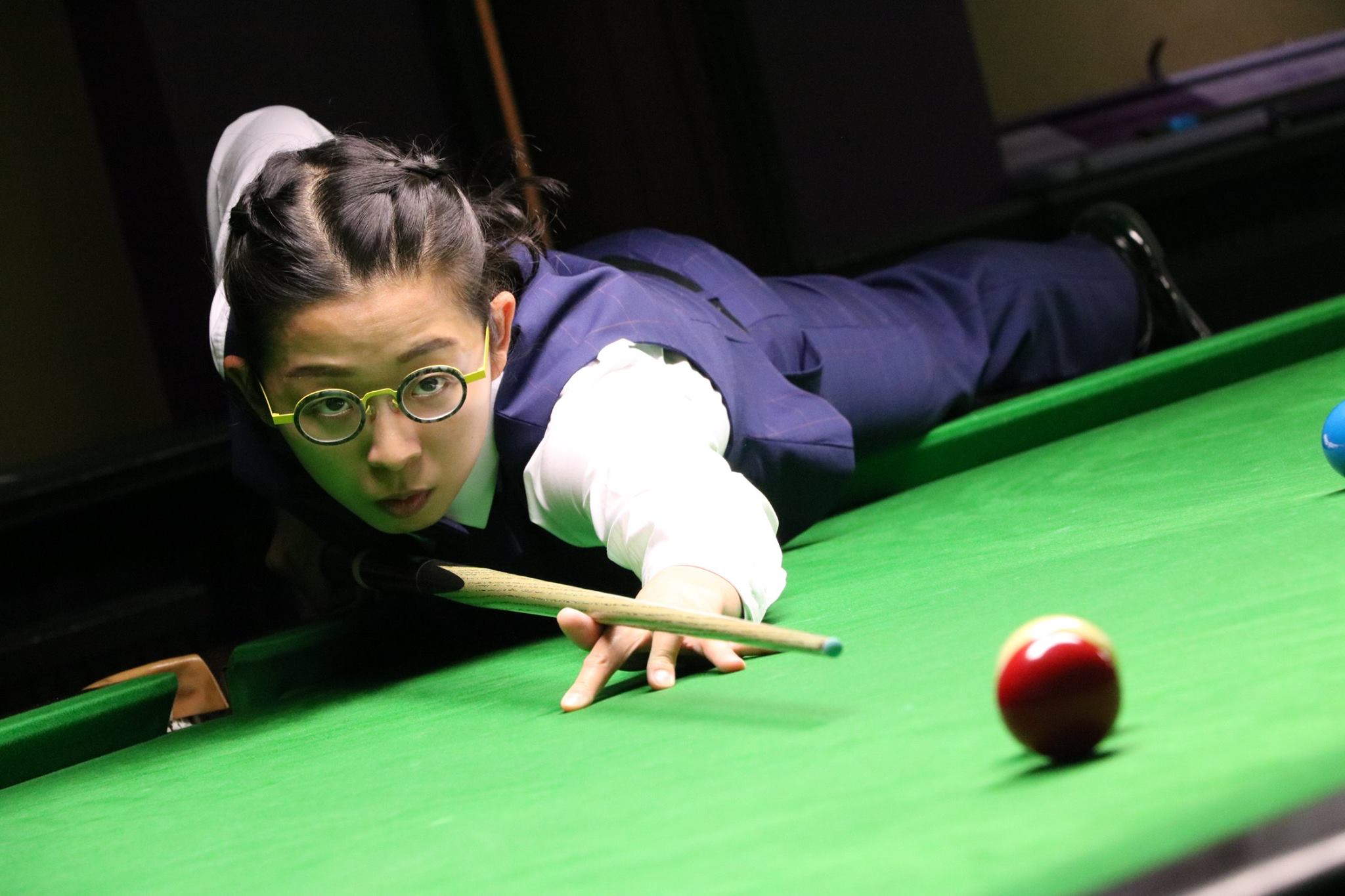
And Mink Nutcharut, who has won the event once and is also known as the 1st female player to make a verified 147 maximum break during a practice match.

Women’s role in snooker is not only limited to playing the game. There are also women who work as coaches, referees, and commentators.
For example, Michaela Tabb was a well-known snooker referee who officiated at many high-profile matches, including the World Snooker Championship final.
/origin-imgresizer.eurosport.com/2015/03/19/1439185-30780603-2560-1440.jpg)
Snooker Tournaments
The most significant snooker tournaments
There are myriads of snooker tournaments to choose from, but we will restrict ourselves to mentioning only the most significant of them all: The Triple Crown.
Triple Crown are the 3 most prestigious and historic tournaments in professional snooker:
- World Snooker Championship
- The Masters
- UK Championship
Players who win all 3 tournaments throughout their career are said to have won the Triple Crown.
🏆 Ronnie O’Sullivan has won a record 21 Triple Crown events.
The World Snooker Championship: The premier event in the snooker calendar, the World Snooker Championship is held annually at the Crucible Theatre in Sheffield, England. With a history dating back to 1927 and a prize pool of over 1 million pounds! It’s the oldest and most prestigious professional snooker tournament, and the winner is crowned the World Snooker Champion.
The Masters: Also known as the Dafabet Masters, this invitational event is held annually at the Alexandra Palace in London. It features the top 16 ranked players in the world for a chance to win the £600,000 prize money.
The UK Championship: A ranking event on the World Snooker Tour, the UK Championship is held annually in November or December. It was first held in 1977 and offers a prize of £850,000.
These tournaments surely make snooker an exciting sport to watch on TV!
Time To Play!
Time to pick up the cue!
Snooker is an awesome sport – yes I am biased because I’m a snooker freak but seriously, trust me.
It’s impossible not to see why snooker is one of the most well-loved and popular sports on TV today! With so many exceptional players and high-stakes championships with intense competition, snooker is undeniably a thrilling sport on TV!
It has been played for decades and draws some of the most passionate sports fans in the world. From the Crucible to your first match at a local club, every snooker match is a blast.
There is low barrier to entry when it comes to getting started in snooker. The public clubs and equipment are inexpensive. Age isn’t a barrier either, you can pick up the rules quickly, and as long as your opponent is at a similar skill level, you’ll have a great time.
If you have any feedback or questions about anything covered in this article, please feel free to submit a comment below.

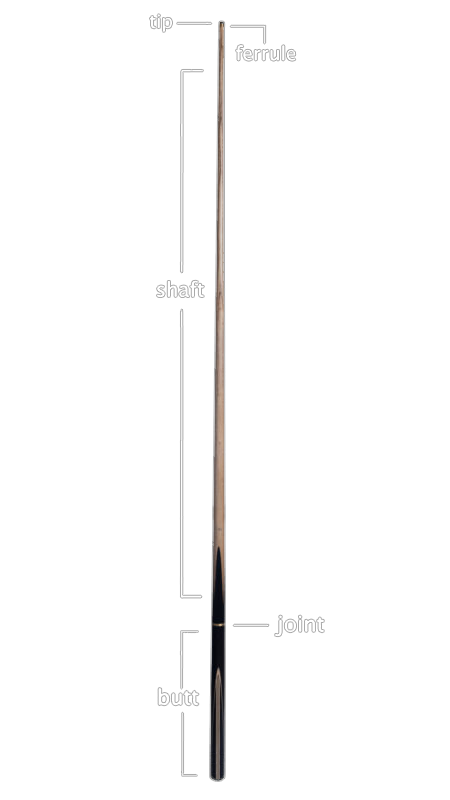
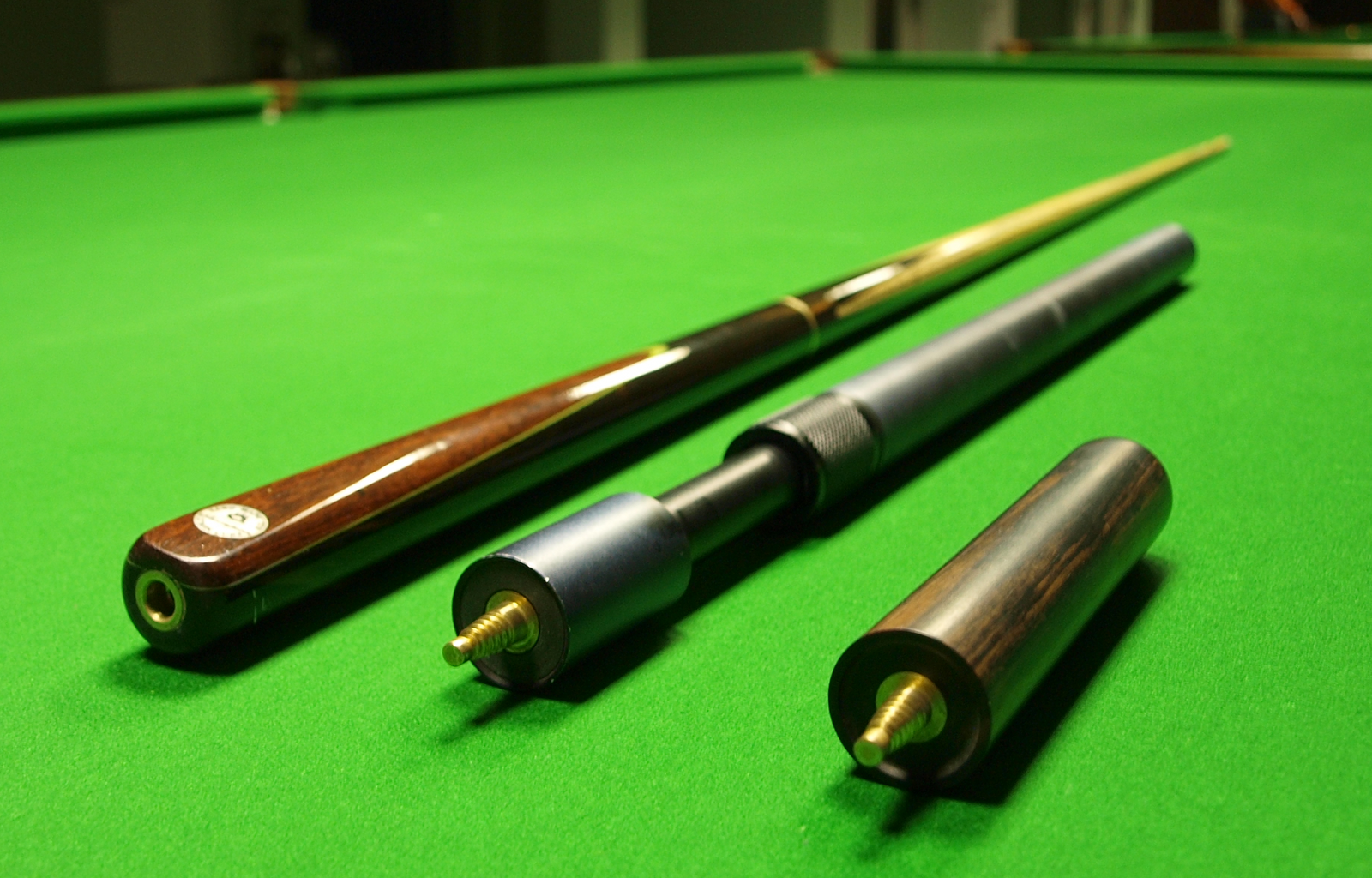





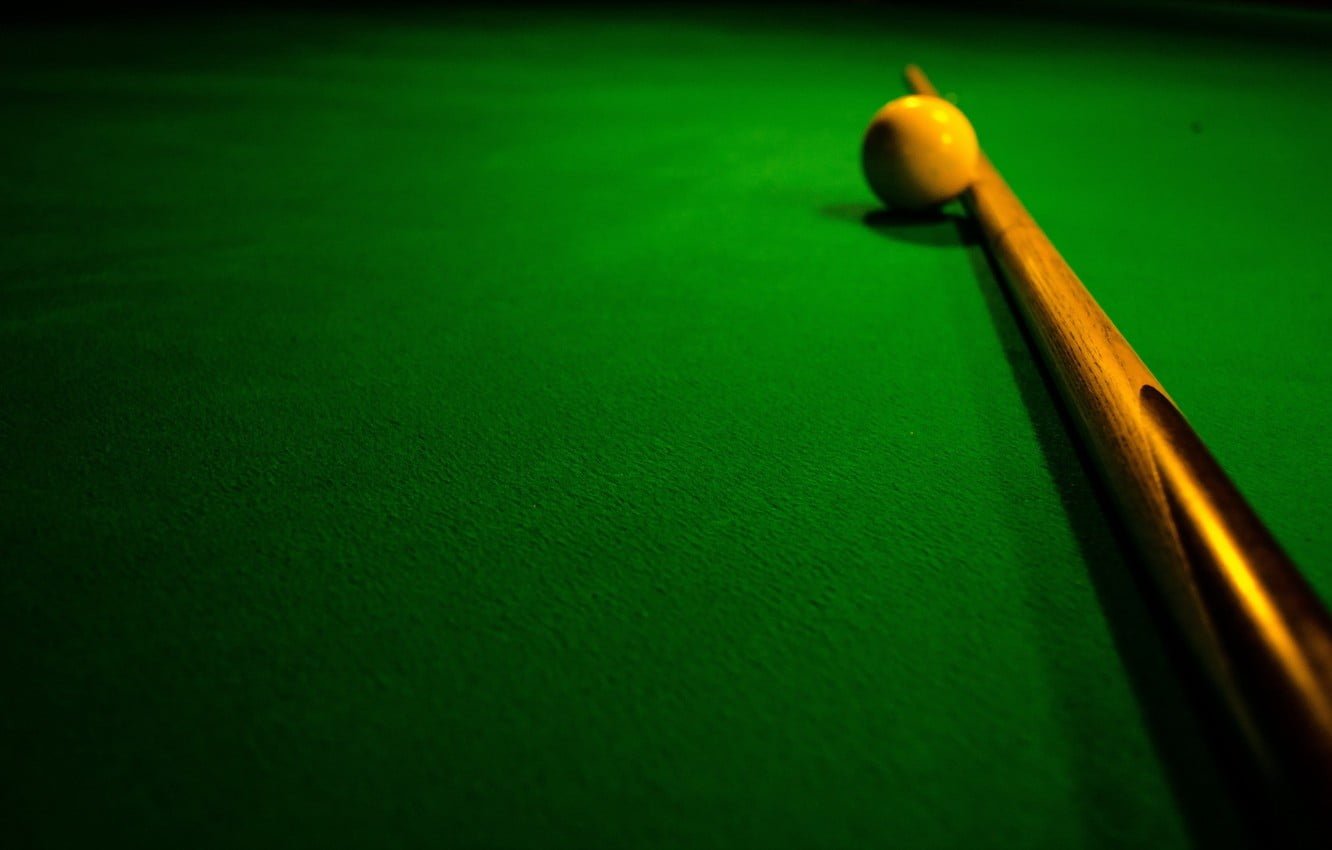
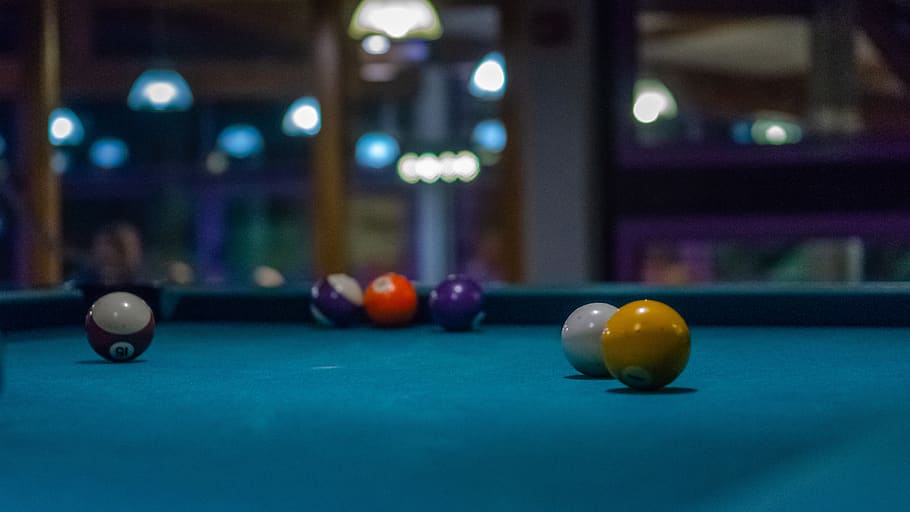
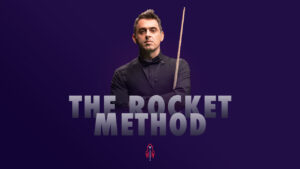


Very thorough and well written article, thanks!
Such a good article, very interesting